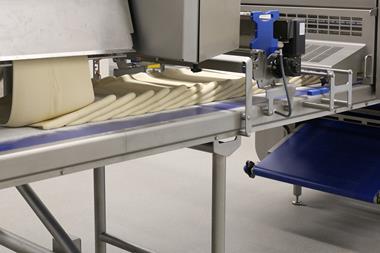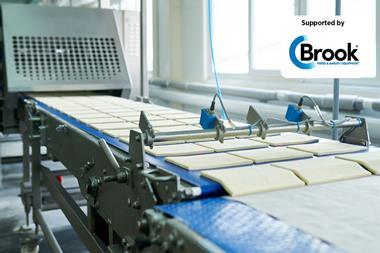Sticky, wet and easily damaged, artisan breads require careful handling, but suppliers of dividing and moulding equipment have risen to the challenge.
While bakers could once rely on producing only tin loaves and a handful of other goods, the modern consumer is discerning, demanding and fickle. This has led to the development of equipment flexible enough to produce a range of goods while gentle enough to cope with speciality and artisan-style doughs.
The days of facilities having just a standard plant for English-style tinned products have gone, says Ann Wells, group marketing director at Polin supplier Brook Food Processing Equipment.
“The introduction of specialist machinery for products such as focaccia, ciabatta and grissini is now common in UK bakeries that are looking to supply customers with a broader choice of authentic Continental breads,” she adds.
One attribute many artisan and specialist breads have in common is an open texture, and such highly fermented doughs can be an issue for some dividers or moulders.
“The high levels of gas in fermented dough create a challenge as normal volumetric dividers exert a lot of pressure on the dough and will damage fermentation,” suggests Creeds managing director Laurent Valbret.
Colbake machines, which Creeds sells in the UK, have been created for artisan-style doughs, he adds. “In their range of machines is a volumetric divider specific for fermented dough. It divides the dough as if it was being divided by hand, without degassing or stressing it.”
Jestic is the exclusive UK distributor of the Glimek range of automatic suction-fed dough dividers that are designed to help maintain air content and texture.
“To produce a quality artisan-style bread, it is crucial bakers use a divider that maintains the texture and hydration levels of the dough,” says Jestic national sales manager Richard Norman.
Baker Perkins, meanwhile, produces the Accurist 2.1 ram and knife divider, designed to achieve gentle handling by moving the dough slowly through the divider.
“Servo control preserves cell structure by minimising shear, compression and ram movement,” explains marketing manager Alan Burgess. “Pressure on the dough is reduced to preserve the structure carefully developed in the mixer, while maintaining scaling accuracy.”
To help meet demand for authentic Continental breads, Mecatherm has launched the M-NS Divider to enable large-volume bakers to produce authentic-style French baguettes. “It generates dough pieces without stretch, shearing and stress,” according to EPP, which supplies Mecatherm kit in the UK and Ireland.
Highly hydrated doughs can be sticky which, as well as making handling difficult, can be a concern when it comes to cleaning. This is particularly relevant given the spotlight on allergen issues and specialist diets such as gluten-free.
For this reason, some bakers opt to use a dedicated piece of kit to handle allergen-free dough, although suppliers have worked to ensure their machines can be cleaned down as thoroughly as possible.
Handtmann has refined the designs of all its machines to improve hygiene and ease of cleaning, with its dough dividers having a smooth surface design that can be fully wet-cleaned with low-pressure cleaners.
Meanwhile, Mono machines are treated with technology based on silver particles that provide non-stick and anti-bacterial protection. “Our dividers have been designed for all types of doughs – even sticky ones,” says sales director Chris Huish.
Whatever consumers demand of bakers in the future, it seems modern divider moulders will help them handle it.
A beginner’s guide to dividers and moulders
Considering investing in dough-handling equipment? EPP managing director Steve Merritt answers some key questions
What options are available to a baker when it comes to equipment?
The first – and by far the most common and most accurate – is the traditional volumetric divider. Put simply, they divide a quantity of dough into pieces of equal weight. Dough is drawn into the multiple pockets of the unit’s horizontal scaling cylinder, sheared off, and ejected onto continuous rounding belts.
The second option involves using a dough sheeter or stress-free equipment. Here, the dividing process is usually carried out by extruding the dough and then revolving knives cut pieces from the sheet into squares, which are then rounded. This method has its advantages, but it is not as accurate as a volumetric divider/rounder.
For larger breads and heavier dough weights you may need to separate components if you want to divide and round particularly sticky doughs, such as a rye dough, and doughs with a very high water content, for which specialist machinery is available.
What are the issues to consider when looking for a suitable divider and moulder?
Bakers should always take into account:
- The type of doughs they are mixing, particularly how sticky they are and their hydration levels
- The scaling weight range needed
- Capacity requirements – ie the number of rounded dough pieces they need to produce each hour, day and week.
What are the benefits of dividers and moulders for the baker?
The benefits of automation are now well documented, with labour cost savings still remaining increasingly important.
For example, the König two-pocket Mini-Rex automatic dough dividing and rounding machine produces up to 4,000 pieces an hour, doing the work of two men in a fraction of the time.
Previously, you would have had to cut a piece of dough out of the mixing bowl, hand-scale and hand-mould it. If, for example, you were using an intermediate bun divider/rounder that rounds 36 pieces at a time, you would have to hand-cut, scale and mould a 1.8kg dough piece before you put it into a box, leave it to rest and then process it – to spread it evenly across the plate is not that easy. An automatic divider/rounder is speedy, accurate and (probably most important of all to the modern bakery) consistent.
How much can a bakery expect to pay for such equipment?
Prices for a basic divider/rounder start at around £15,000 and can rise up to over £200,000 for large-capacity machines. Remember, this is the price for a single piece of machinery and not for the option mentioned earlier that requires separate components and does not include optional extras, such as a seeding unit.
What should bakers be able to expect from their dividers and moulders in terms of reliability and longevity?
At EPP, we recently replaced a divider/rounder that had been producing 18,000 dough pieces an hour, day in, day out at a central bakery for one of this country’s leading retail bakery chains that was just coming up to 35 years old. Properly looked after and regularly serviced, this is the life expectancy bakers can expect from a quality manufacturer.





























No comments yet